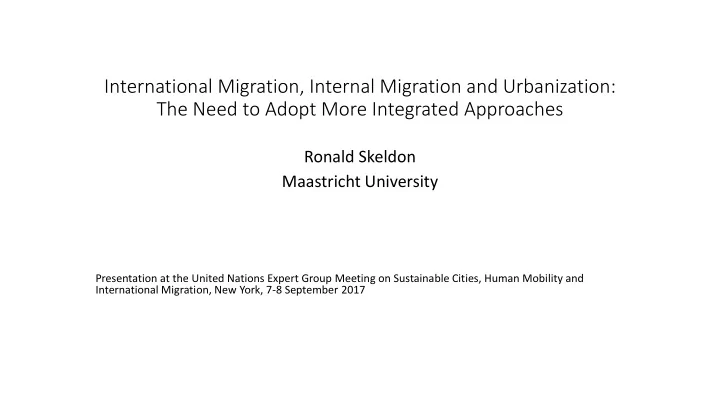

International Migration, Internal Migration and Urbanization: The Need to Adopt More Integrated Approaches Ronald Skeldon Maastricht University Presentation at the United Nations Expert Group Meeting on Sustainable Cities, Human Mobility and International Migration, New York, 7-8 September 2017
Structure of presentation • Issues inherent to migration data in general • Time and space • International migration • Specific origins and destinations • Return movements • Levels of development • Internal migration • Urbanization • Linkages between internal and international migration • New mobilities • Migration and the 2030 Global Agenda
Comparison of permanent immigrant intakes and some of the major channels of temporary entry, the United States, 2001-2012 2001 2006 2010 2012 UNITED STATES Persons obtaining legal 1,058,902 1,266,129 1,042,625 1,031,631 permanent resident status Temporary worker and 1,541,703 1,709,268 2,816,525 3,049,419 their family admissions Student and family 741,921 740,724 1,595,078 1,653,576 admissions
Migration in the SDGs: the direct effects (see World Bank 2016) • Safe, orderly and regular migration - 10.7 • Combat trafficking – 5.2; 8.7; 16.2 • Promote decent labour conditions for migrant workers – 8.8 • Reduction in the cost of remittances – 10c • Students and scholarships – 4b • Health workers – 3.e • What is missing 1? • How can 10.7 be achieved without 16.9 (provide legal identity for all, including birth registration) • What is missing 2? • Technology figures prominently in the SDGs (8.2; 9.5; 9b;12a; but the substitution of capital for labour is never envisaged. That is, the automation of human activities that may impact upon the demand for labour is not incorporated.
Migration and the SDGs: the indirect effects • What are the implications for migration of seeking to achieve the targets specified in the SDGs? For example, most of the targets listed under 9 (build resilient infrastructure, promote inclusive and sustainable industrialization) and 11 (make cities and human settlements inclusive, safe, resilient and sustainable) will have profound implications for human mobility, although some implication for migration could probably be found for the majority of targets specified
The SDGs: the fundamental flaws for migration • The SDGs are primarily a state-centred plan for action • Subnational data need to be collected on migration corridors (and city regions) not just interstate flows and disaggregated by topics for “national contexts” (17.18) • The SDGs do not plan for a future world but one constrained by current structures, boundaries and technologies. The demand for labour is consequent upon our technology and may not exist indefinitely. • Migration is seen primarily as an active agent rather than a consequence of existing and/or planned inequalities. Migration is not a “thing” in itself to be managed but a consequence of development, a development that itself needs to be managed in order to bring some coherence to any plan for migration. Unless migration is seen in this way it is nothing but a prop for continued bureaucratic attention instead any real concern for the movement of human beings.
Recommend
More recommend